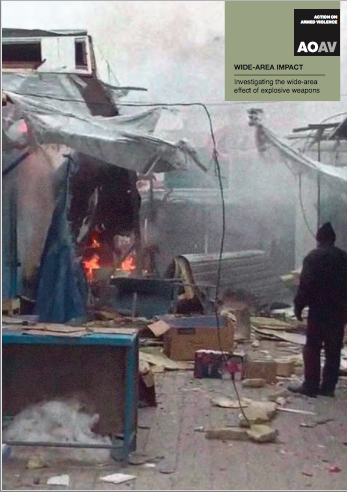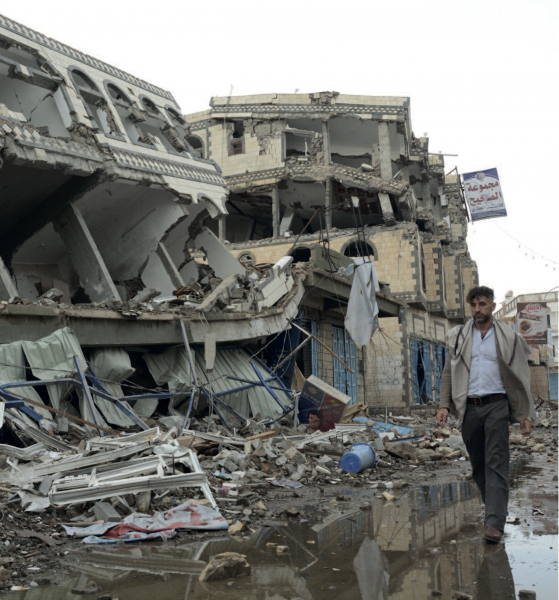 Stopping the use of explosive weapons with wide area effects in populated areas is a humanitarian priority. INEW member Action on Armed Violence (AOAV) this week released a new report looking in detail at the impact of three types of explosive weapons with wide-area effects, gathering further evidence to demonstrate the devastating impact for civilians when such weapons are used in populated areas – and showing why states must urgently address this issue.
Stopping the use of explosive weapons with wide area effects in populated areas is a humanitarian priority. INEW member Action on Armed Violence (AOAV) this week released a new report looking in detail at the impact of three types of explosive weapons with wide-area effects, gathering further evidence to demonstrate the devastating impact for civilians when such weapons are used in populated areas – and showing why states must urgently address this issue.
Explosive weapons with wide area effects create blast and fragmentation over a large area on the ground. Where the weapons affect a wide area it is difficult to limit the harm that they will cause if used in areas where civilians are concentrated. Explosive weapons that affect a wide area on the ground therefore create an excessive risk to civilians if used in populated areas.
AOAV’s report looks at the impact of air-dropped bombs in Yemen, mortar attacks on the Syrian-Jordanian border and multiple-rocket attacks in Ukraine. It uses case studies to explore how the technical characteristics that give a weapon wide-area impacts translate into severe and long-lasting harm on the ground. Three key factors – the quantity of explosives, the number of munitions and the accuracy of the weapon – can work on their own or in combination to create wide area effects. The case studies in the report are chosen to look at each of these.

The city of Sa’ada has been heavily hit by airstrikes during the conflict in Yemen in 2015 (Philippe Krops/OCHA)
In Yemen, AOAV looked at the impact of Paveway air-dropped bombs, which have a wide-impact area impact due to the large quantity of explosives and destructive radius of the individual munition used, producing:
- An overview of air-dropped bombs used by the Saudi-led coalition in Yemen;
- A case study of an aerial strike on a Yemeni family home;
- An examination of certain air-dropped bombs, with a focus on the Mark 80 series with Paveway attachments (with technical details);
- An infographic and video of the guided Mark 80 series in action, with additional eye-witness testimony from AOAV’s researcher.
AOAV examined the impact of mortar fire the Syrian/Jordanian border as an example of weapons that have a wide impact area due to inaccuracy of the delivery system, producing:
- An overview of mortar fire on the Syrian/Jordanian border;
- A case study of a lethal mortar strike in Ramtha, on the Syrian border;
- An examination of certain explosive weapons with a lack of accuracy, with a focus on mortars (M-1943/M43);
- A video of the mortar attacks, along with an infographic, with an additional gallery of the type of mortars used on the Syrian/Jordanian border;
- AOAV also produced a map of where 15 recorded strikes landed, along with 15 case studies of each strike laid out in detail.

Destruction caused by explosive weapons in Ukraine (© Human Rights Watch 2015)
In Ukraine AOAV looked at the effects of the Grad multiple launch rocket system, as an example of a system with a wide-area impact due to its delivery of multiple munitions over an area, producing:
- An overview of the use of multi-launch rocket systems in the Ukrainian conflict;
- A case study of Grad rockets killing dozens of civilians in an attack on the Eastern European town of Mariupol in January, 2015;
- An analysis of the Grad rocket system, with an accompanying video and infographic;
- Details of a particular strike and a map of where one salvo of 40 of the Grad rockets landed in Mariupol.
INEW is calling on states to develop an international political commitment to begin to address the harm caused by the use of explosive weapons in populated areas. An increasing number of states are calling for action on this problem, and Austria has commenced a process towards a commitment on this issue.
